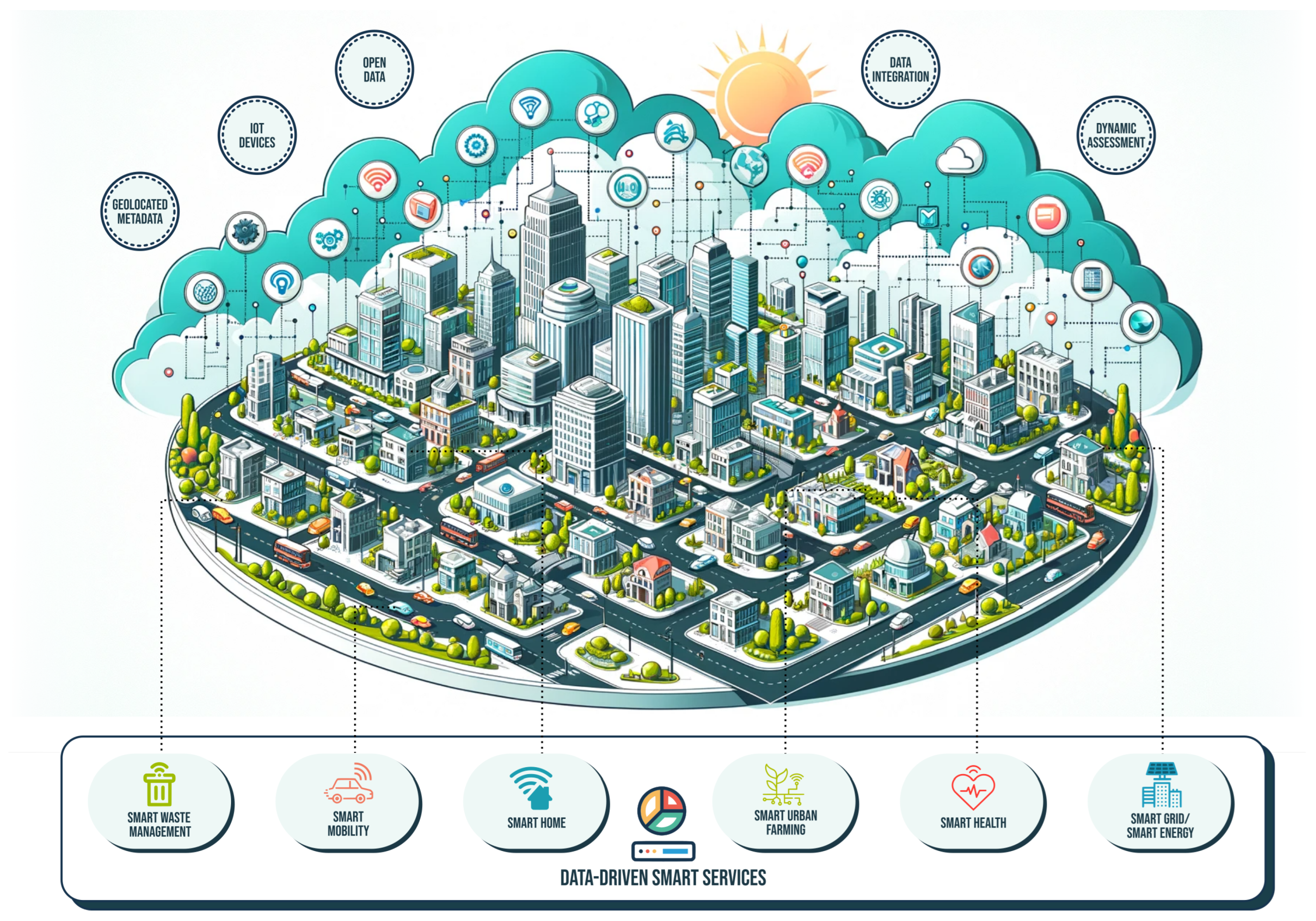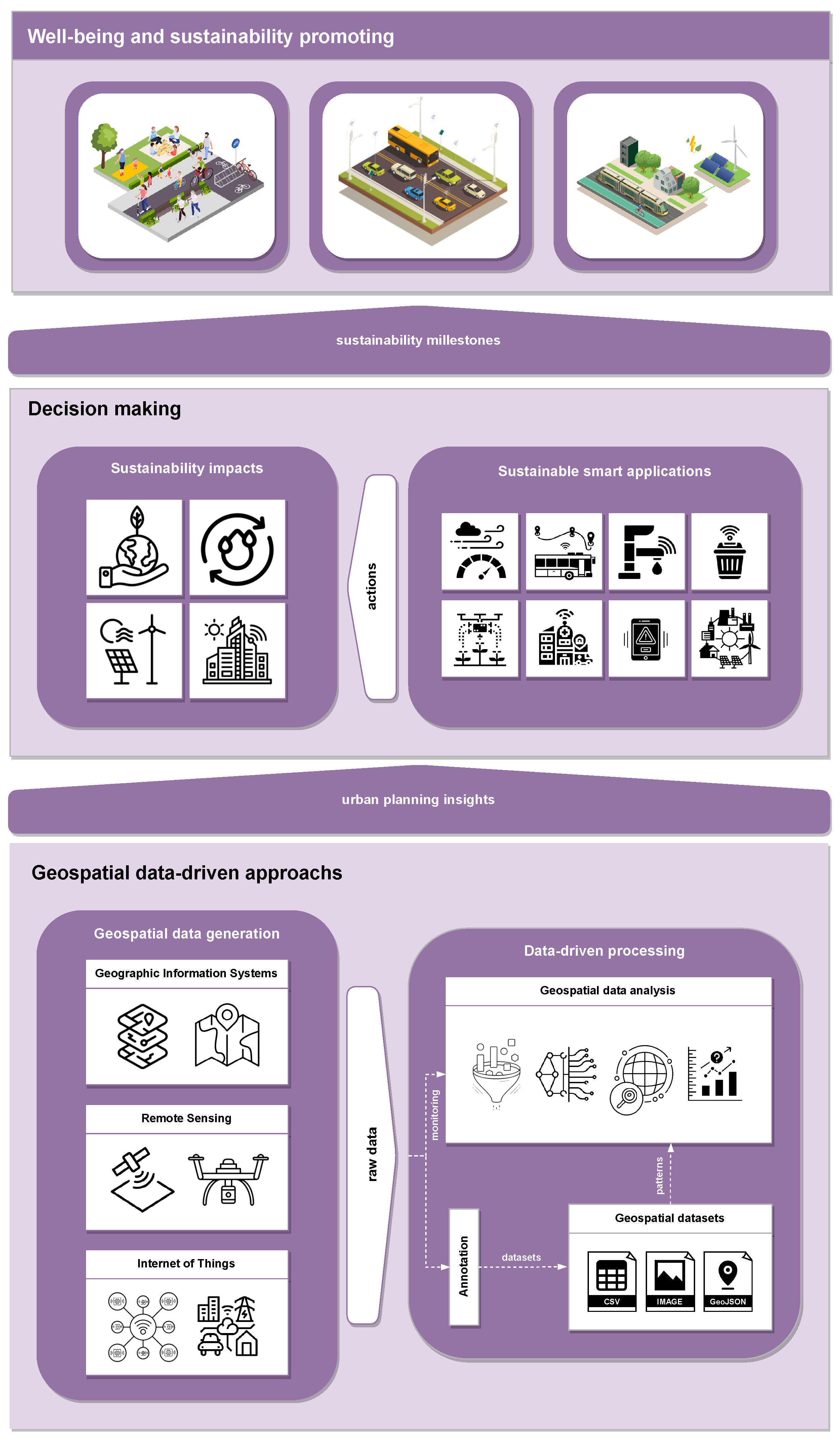
| Version | Summary | Created by | Modification | Content Size | Created at | Operation |
|---|---|---|---|---|---|---|
| 1 | João Carlos N. Bittencourt | -- | 3503 | 2024-01-26 13:08:42 | | | |
| 2 | Peter Tang | + 2 word(s) | 3505 | 2024-01-29 03:44:34 | | |
Video Upload Options
The concept of smart cities has become increasingly important in the pursuit of sustainable development goals. In general, common urban challenges have been addressed through smart-city services, and new perspectives for more sustainable cities have emerged. To realise the full potential of such smart urban environments, geospatial approaches have been used as a focal point, offering a plethora of applications that contribute to a better understanding of urban challenges and innovation potentials.
1. Introduction
2. Smart Cities and Sustainability
|
SDG |
Goal |
Category |
||
|---|---|---|---|---|
|
Environment |
Economy |
Social |
||
|
1 |
No poverty |
|
|
|
|
2 |
Zero hunger |
|
|
|
|
3 |
Good health and well-being |
|
||
|
4 |
Quality education |
|
||
|
5 |
Gender equality |
|
||
|
6 |
Clean water and sanitation |
|
||
|
7 |
Affordable and clean energy |
|
|
|
|
8 |
Decent work and economic growth |
|
|
|
|
9 |
Industry, innovation and infrastructure |
|
||
|
10 |
Reduced inequalities |
|
|
|
|
11 |
Sustainable cities and communities |
|
|
|
|
12 |
Responsible consumption and production |
|
|
|
|
13 |
Climate action |
|
||
|
14 |
Life below water |
|
||
|
15 |
Life on land |
|
||
|
16 |
Peace, justice and strong institutions |
|
||
|
17 |
Partnerships for the goals |
|
|
|

3. Geospatial Urban Data Processing
4. Geospatial Datasets and Management of Georeferenced Data
5. Sustainable Smart-City Applications

-
Pollution monitoring: using data to monitor and reduce air and water pollution and promote healthier urban environments;
-
Smart urban mobility: implementing data-driven solutions to optimize traffic, support public transport, and promote sustainable mobility options;
-
Efficient water management: using insights to improve water resource management, reduce waste and ensure equitable access to clean water;
-
Sustainable waste management: applying technologies to monitor, collect, and sustainably manage waste, therefore contributing to the reduction of environmental impacts;
-
Smart urban farming: the use of geospatially enabled agricultural practices to increase efficiency, reduce resource use, and promote sustainable agriculture;
-
Smart health: leveraging data to monitor health indicators, prevent disease, and improve the quality of health services in the city;
-
Emergency management: integrating policies and technologies to assess, monitor, and respond to disaster risks, therefore increasing urban resilience;
-
Smart grids: incorporating advanced technologies to optimize energy distribution, increase efficiency, and promote renewable energy sources.
References
- Ahad, M.A.; Paiva, S.; Tripathi, G.; Feroz, N. Enabling technologies and sustainable smart cities. Sustain. Cities Soc. 2020, 61, 102301.
- De Guimarães, J.C.F.; Severo, E.A.; Júnior, L.A.F.; Da Costa, W.P.L.B.; Salmoria, F.T. Governance and quality of life in smart cities: Towards sustainable development goals. J. Clean. Prod. 2020, 253, 119926.
- Hashem, I.A.T.; Usmani, R.S.A.; Almutairi, M.S.; Ibrahim, A.O.; Zakari, A.; Alotaibi, F.; Alhashmi, S.M.; Chiroma, H. Urban Computing for Sustainable Smart Cities: Recent Advances, Taxonomy, and Open Research Challenges. Sustainability 2023, 15, 3916.
- Tura, N.; Ojanen, V. Sustainability-oriented innovations in smart cities: A systematic review and emerging themes. Cities 2022, 126, 103716.
- Gracias, J.S.; Parnell, G.S.; Specking, E.; Pohl, E.A.; Buchanan, R. Smart Cities—A Structured Literature Review. Smart Cities 2023, 6, 1719–1743.
- Kim, H.; Choi, H.; Kang, H.; An, J.; Yeom, S.; Hong, T. A systematic review of the smart energy conservation system: From smart homes to sustainable smart cities. Renew. Sustain. Energy Rev. 2021, 140, 110755.
- Branny, A.; Møller, M.S.; Korpilo, S.; McPhearson, T.; Gulsrud, N.; Olafsson, A.S.; Raymond, C.M.; Andersson, E. Smarter greener cities through a social-ecological-technological systems approach. Curr. Opin. Environ. Sustain. 2022, 55, 101168.
- Bellini, P.; Nesi, P.; Pantaleo, G. IoT-enabled smart cities: A review of concepts, frameworks and key technologies. Appl. Sci. 2022, 12, 1607.
- Costa, D.G.; Peixoto, J.P.J.; Jesus, T.C.; Portugal, P.; Vasques, F.; Rangel, E.; Peixoto, M. A Survey of Emergencies Management Systems in Smart Cities. IEEE Access 2022, 10, 61843–61872.
- Almalki, F.A.; Alsamhi, S.H.; Sahal, R.; Hassan, J.; Hawbani, A.; Rajput, N.; Saif, A.; Morgan, J.; Breslin, J. Green IoT for eco-friendly and sustainable smart cities: Future directions and opportunities. Mob. Netw. Appl. 2023, 28, 178–202.
- Sarker, I.H. Smart City Data Science: Towards data-driven smart cities with open research issues. Internet Things 2022, 19, 100528.
- Kaluarachchi, Y. Implementing data-driven smart city applications for future cities. Smart Cities 2022, 5, 455–474.
- Bibri, S.E. Data-driven smart sustainable cities of the future: An evidence synthesis approach to a comprehensive state-of-the-art literature review. Sustain. Future 2021, 3, 100047.
- Stübinger, J.; Schneider, L. Understanding smart city—A data-driven literature review. Sustainability 2020, 12, 8460.
- Hui, C.X.; Dan, G.; Alamri, S.; Toghraie, D. Greening smart cities: An investigation of the integration of urban natural resources and smart city technologies for promoting environmental sustainability. Sustain. Cities Soc. 2023, 99, 104985.
- Paes, V.d.C.; Pessoa, C.H.M.; Pagliusi, R.P.; Barbosa, C.E.; Argôlo, M.; de Lima, Y.O.; Salazar, H.; Lyra, A.; de Souza, J.M. Analyzing the Challenges for Future Smart and Sustainable Cities. Sustainability 2023, 15, 7996.
- Bibri, S.E. A novel model for data-driven smart sustainable cities of the future: The institutional transformations required for balancing and advancing the three goals of sustainability. Energy Inform. 2021, 4, 37.
- Thellufsen, J.Z.; Lund, H.; Sorknæs, P.; Østergaard, P.; Chang, M.; Drysdale, D.; Nielsen, S.; Djørup, S.; Sperling, K. Smart energy cities in a 100% renewable energy context. Renew. Sustain. Energy Rev. 2020, 129, 109922.
- Farmanbar, M.; Parham, K.; Arild, Ø.; Rong, C. A widespread review of smart grids towards smart cities. Energies 2019, 12, 4484.
- Colmenares-Quintero, R.F.; Maestre-Gongora, G.; Valderrama-Riveros, O.C.; Baquero-Almazo, M.; Stansfield, K.E. A Data-Driven Architecture for Smart Renewable Energy Microgrids in Non-Interconnected Zones: A Colombian Case Study. Energies 2023, 16, 7900.
- Afrin, T.; Yodo, N. A Survey of Road Traffic Congestion Measures towards a Sustainable and Resilient Transportation System. Sustainability 2020, 12, 4660.
- Albuquerque, V.; Oliveira, A.; Barbosa, J.L.; Rodrigues, R.S.; Andrade, F.; Dias, M.S.; Ferreira, J.C. Smart cities: Data-driven solutions to understand disruptive problems in transportation—The Lisbon Case Study. Energies 2021, 14, 3044.
- Bibri, S.E. Compact urbanism and the synergic potential of its integration with data-driven smart urbanism: An extensive interdisciplinary literature review. Land Use Policy 2020, 97, 104703.
- Sun, J.; Zhou, T. Urban shrinkage and eco-efficiency: The mediating effects of industry, innovation and land-use. Environ. Impact Assess. Rev. 2023, 98, 106921.
- Marchesani, F.; Masciarelli, F.; Bikfalvi, A. Smart city as a hub for talent and innovative companies: Exploring the (dis)advantages of digital technology implementation in cities. Technol. Forecast. Soc. Change 2023, 193, 122636.
- Richter, M.A.; Hagenmaier, M.; Bandte, O.; Parida, V.; Wincent, J. Smart cities, urban mobility and autonomous vehicles: How different cities needs different sustainable investment strategies. Technol. Forecast. Soc. Change 2022, 184, 121857.
- Rodríguez Bolívar, M.P.; Alcaide Muñoz, L.; Alcaide Muñoz, C. Identifying patterns in smart initiatives’ planning in smart cities. An empirical analysis in Spanish smart cities. Technol. Forecast. Soc. Change 2023, 196, 122781.
- Meijer, A.; Thaens, M. Path Dependency of Smart Cities: How Technological and Social Legacies Condition Smart City Development. In Smart Cities and Smart Governance: Towards the 22nd Century Sustainable City; Springer: Cham, Switzerland, 2021; pp. 31–42.
- Shamsuzzoha, A.; Nieminen, J.; Piya, S.; Rutledge, K. Smart city for sustainable environment: A comparison of participatory strategies from Helsinki, Singapore and London. Cities 2021, 114, 103194.
- Sugandha; Freestone, R.; Favaro, P. The social sustainability of smart cities: A conceptual framework. City Cult. Soc. 2022, 29, 100460.
- Allam, Z.; Sharifi, A.; Bibri, S.E.; Jones, D.S.; Krogstie, J. The Metaverse as a Virtual Form of Smart Cities: Opportunities and Challenges for Environmental, Economic, and Social Sustainability in Urban Futures. Smart Cities 2022, 5, 771–801.
- Macke, J.; Rubim Sarate, J.A.; de Atayde Moschen, S. Smart sustainable cities evaluation and sense of community. J. Clean. Prod. 2019, 239, 118103.
- Bouzguenda, I.; Alalouch, C.; Fava, N. Towards smart sustainable cities: A review of the role digital citizen participation could play in advancing social sustainability. Sustain. Cities Soc. 2019, 50, 101627.
- Sun, Y.; Du, Y. Big data and sustainable cities: Applications of new and emerging forms of geospatial data in urban studies. Open Geospat. Data Softw. Stand. 2017, 2, 24.
- Golchehr, S.; Bueno De Mesquita, N. Data-Driven Design for Civic Participation Introducing Digital Methods for On-Going Civic Engagement for Design in Public Space; Taylor and Francis: London, UK, 2018; pp. 57–70.
- Brugali, D. Model-Driven Software Engineering in Robotics: Models Are Designed to Use the Relevant Things, Thereby Reducing the Complexity and Cost in the Field of Robotics. IEEE Robot. Autom. Mag. 2015, 22, 155–166.
- Wang, Z.; Qu, H.; Wu, Z.; Yang, H.; Du, Q. Formal representation of 3D structural geological models. Comput. Geosci. 2016, 90, 10–23.
- Darwish, S.; Bagi, N.; Madbouly, M. Clustering big data based on distributed fuzzy k-medoids: An application to geospatial informatics. IEEE Access 2022, 10, 20926–20936.
- Kirimtat, A.; Krejcar, O.; Kertész, A.; Taşgetiren, M. Future trends and current state of smart city concepts: A survey. IEEE Access 2020, 8, 86448–86467.
- Huang, W.; Kazemzadeh, K.; Mansourian, A.; Harrie, L. Towards knowledge-based geospatial data integration and visualization: A case of visualizing urban bicycling suitability. IEEE Access 2020, 8, 85473–85489.
- Wang, H.; Liu, Y.; Zhang, G.; Wang, Y.; Jing, Z. Multi-scenario simulation of urban growth under integrated urban spatial planning: A case study of wuhan, china. Sustainability 2021, 13, 11279.
- Jing, C.; Du, M.; Li, S.; Liu, S. Geospatial dashboards for monitoring smart city performance. Sustainability 2019, 11, 5648.
- He, P.; Almasifar, N.; Mehbodniya, A.; Javaheri, D.; Webber, J.L. Towards green smart cities using Internet of Things and optimization algorithms: A systematic and bibliometric review. Sustain. Comput. Inform. Syst. 2022, 36, 100822.
- Amirzadeh, M.; Sobhaninia, S.; Sharifi, A. Urban resilience: A vague or an evolutionary concept? Sustain. Cities Soc. 2022, 81, 103853.






























